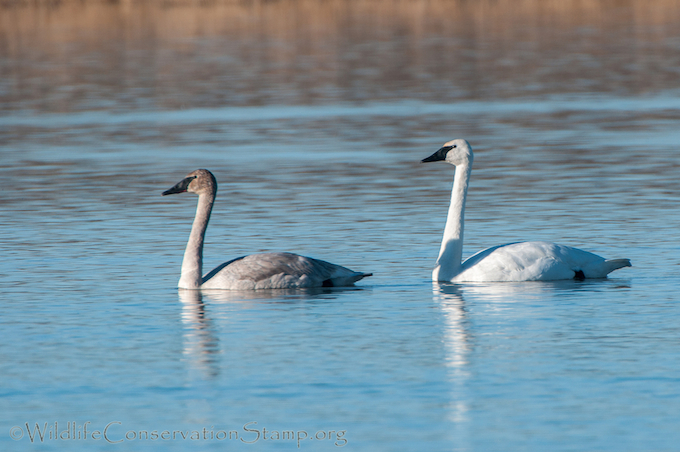
Trumpeter Swan (Cygnus buccinator) Adult and Immature – photo by Larry Jordan
Check out my latest West Coast Beat Writer post on the Trumpeter Swans I saw at Chico’s Oxidation Ponds last week! Click on photo for full sized image.

Trumpeter Swan (Cygnus buccinator) Adult and Immature – photo by Larry Jordan
Check out my latest West Coast Beat Writer post on the Trumpeter Swans I saw at Chico’s Oxidation Ponds last week! Click on photo for full sized image.
The United Nations Department of Public Information, Oceanic Preservation Society (OPS), founded by photographer and Academy Award-winning director Louie Psihoyos (THE COVE), Obscura Digital, a creative technology studio that has staged multi-sensory media experiences all over the globe, and Fisher Stevens, Academy Award-winning Producer of THE COVE, lit up the United Nations headquarters in a revolutionary call to action for citizens of the world to demand action from their leaders to protect the world’s ecosystems.
If this doesn’t bring tears to your eyes, I don’t know what would.
On Martin Luther King Day, a quote from the reverend:
Human progress is neither automatic nor inevitable… Every step toward the goal of justice requires sacrifice, suffering, and struggle; the tireless exertions and passionate concern of dedicated individuals.
There is however, a World of Soulutions

President Obama has made it clear that Keystone XL can’t be in our national interest — and thus must be rejected — if it increases carbon pollution and makes climate change worse.
It has always been clear that Keystone XL will do just that. In 2014 alone, three major tar sands projects were canceled because they were simply unprofitable given rising costs, lower oil prices and lack of market access from pipelines like Keystone XL. Approving Keystone XL would open the floodgates of climate-damaging tar sands crude flowing through the U.S. — which is just what Big Oil needs to expand production.
The House of Representatives overwhelmingly passed a bill on Friday authorizing the Keystone XL oil pipeline, despite a renewed pledge by the White House to veto the legislation after a Nebraska court removed a major obstacle.
Listen to this NPR interview with Brian Jorde, the lawyer for the Nebraska landowners trying to fight for their property rights, explaining why this might actually be a blow to TransCanada.
If you have never seen the devastation caused by the mining operations in this Canadian area of Boreal Forest (or what was Boreal Forest), watch this video with Archbishop Desmond Tutu.
It is time for President Obama to kill this project once, and for all time. Stop this abomination before it’s too late for our environment, our clean air and water.
I urge you to send an email to the President (we know how tuned in he is to social media) urging him to permanently settle this argument. Here is a sample letter I received from the Sierra Club that you can use and email it to Barack Obama –
Dear President Obama,
You have consistently promised to reject the Keystone XL pipeline if it would increase carbon pollution and worsen climate change. It is becoming clearer every day that climate-polluting tar sands development needs Keystone XL in order to expand. This means that your decision on Keystone XL will decide whether massive amounts of carbon pollution will be kept safely in the ground, or whether it will be burned to fuel the climate crisis.
In the year since the State Department’s final environmental impact statement was released, it has become obvious that its predictions severely underestimated Keystone XL’s impact on climate. Far from being “inevitable,” tar sands production is faltering. Three major tar sands projects have been canceled in 2014 alone due to the unprofitability of tar sands extraction. The lack of market access is part of this, and contrary to the State Department’s predictions, transporting tar sands by rail has proven not to be an economically-viable alternative to pipelines.
Even the State Department’s biased analysis considered a scenario where low oil prices would mean building Keystone XL would lead to substantial increases in tar sands production — and that scenario is now playing out. Current oil prices have fallen to around $50 a barrel and many analysts see oil prices staying low for quite some time. This is well below the price range of $92 to $145 per barrel the State Department projected would support continued tar sands expansion without Keystone XL. This carbon pollution is in addition to the carbon pollution — equivalent to adding up to 5.7 million cars to the roads — that the State Department predicted even under the most favorable market scenarios.
Mr. President, there’s no way around it — approving Keystone XL is incompatible with your promise to act on climate. You alone have the power to stop this pipeline from irreparably damaging our climate for ourselves and future generations. I urge you to stay true to your word, base your decision on the plain facts in front of you, and reject the climate-damaging Keystone XL pipeline once and for all.
Sincerely,
Sincerely,
[Your Name]
[Your Address]
[City, State ZIP]
As you can see from this last video, Enbridge is trying to run this dirty oil through one of the most pristine areas of coastal forest in British Columbia, Canada’s Great Bear Rainforest.
Nature Needs A Voice

Snow Goose (Chen caerulescens) photos by Larry Jordan
At the end of each year I like to go back and look at the bird photographs I have taken and choose the ones I like the best for a “favorite bird photo” post. I try to pick at least one photograph from each month however some months were photographically prolific, others not so much. Each description gives the camera settings used for that photograph.
All photographs where taken with a Nikon D90, using a Nikon 1.7x teleconverter and Nikon 200-400mm f/4G ED lens unless otherwise noted. Click on photos for full sized images and click on the name of the bird for a link to one of my posts on that species. Many of the posts also include videos.
The Sacramento National Wildlife Refuge Complex consists of five national wildlife refuges (NWR) and three wildlife management areas (WMA) that comprise over 35,000 acres of wetlands and uplands in the Sacramento Valley of California. In addition, there are over 30,000 acres of conservation easements in the Complex. The Refuges and easements are part of the U.S. Fish and Wildlife Service where they serve as resting and feeding areas for nearly half the migratory birds on the Pacific Flyway.
The Snow Goose above was caught in a landing at Colusa NWR, one of the refuges in the complex – taken at 1/2000 sec, f/8, ISO 640. Below, the smaller Ross’s Goose (Chen rossii) was spotted among the Snow Geese on the same day, the photo taken at 1/800 sec, f/10, ISO 320.
The Sacramento NWR Complex offers four photography blinds that may be reserved by lottery. One advantage of shooting from a photography blind is of course, that the wildlife approaches closer to you than they normally would. This photo of a Northern Shoveler (Anas clypeata) drake was taken from the Colusa NWR blind at 1/320 sec, f/10, ISO 200.
In February I attended the Winter Wings Festival in Oregon’s Klamath Basin. Besides the incredible beauty of the area, the festival always offers great photography workshops and field trips.
One of the workshops I attended was the Extreme Raptor Photo Shoot put on by the High Desert Museum, which gave wildlife photographers a chance to capture in flight shots of several of the museum’s education birds. This photo of the Northern Goshawk (Accipiter gentilis) has been processed in photoshop to remove the jesses (short straps fastened around the leg of a captive raptor) and make it look more natural. This is an education bird that cannot be released back into the wild. The photo was taken on an overcast day with the Nikon 70-300 f/4.5-5.6G ED lens at 1/1250 sec, f/5.6, ISO 1000.
Since I apparently didn’t spend much time birding in March I’m going to insert one of my favorite photos of this bright male Western Bluebird (Sialia mexicana) found on my bluebird trail at Lema Ranch in February. I took this at 1/400 sec, f/6.7, ISO 250.
In April, these American White Pelicans (Pelecanus erythrorhynchos) were seen in the company of a couple of Double-crested Cormorants (Phalacrocorax auritus) on the Sacramento River and photographed at 1/160 sec, f/18, ISO 500.
As May rolled around I returned to Modoc NWR in the hope of spotting some Sandhill Crane (Grus canadensis) colts. The refuge is a known breeding ground for these majestic birds where I was lucky to find a pair of adults nurturing two young colts. This photo was taken at 1/160 sec, f/20, ISO 500.
As May turned into June, the Klamath Basin Bird Observatory sponsored the inaugural Mountain Bird Festival. A few of the festival’s target birds would be lifers for me, including the Great Gray Owl (Strix nebulosa). We were able to see a nesting female with her young in a manmade nest structure. These “nestboxes” have enhanced local breeding for these huge owls whose nest success is boosted to 83% on artificial platforms vs. 66% at natural sites. This photo was taken in low light at 1/125 sec, f/6.7, ISO 500.
The other bird I was very excited to get some good shots of is the secretive Green-tailed Towhee (Pipilo chlorurus). This photo was taken in the shrub-steppe habitat where it breeds at 1/60 sec, f/6.7, ISO 200.
During the summer months here, the heat rises and bird activity diminishes but there is always activity at my backyard bird feeders and water feature. We have a resident community of Acorn Woodpeckers (Melanerpes formicivorus) that visit year round and this juvenile was captured in July from my porch at 1/400 sec, f/6.7, ISO 200.
On a scouting trip to one of our local birding hotspots in August, I spotted this Willow Flycatcher (Empidonax traillii) and snapped a few good shots. This one is my favorite at 1/160 sec, f/6.7, ISO 640.
Migrants still filtering through this section of the Pacific Flyway in September offered up a plethora of Yellow Warblers (Setophaga petechia) this year. I photographed this beauty at 1/1000 sec, f/6.7, ISO 800.
Our annual Northern California Audubon Council meeting, in which I was able to participate, took place in October. The 2014 meeting was hosted by Plumas Audubon in this beautiful area surrounding the Feather River. I was privileged to stay with some good friends who have made their home a wildlife sanctuary, offering up a multitude of native species. This Red-breasted Sapsucker (Sphyrapicus ruber) was one of our morning visitors, taken at 1/80 sec, f/6.7, ISO 800.
I have been very busy the last few months and unfortunately have not had ample opportunity to get out and photograph birds. I did however, shoot a video on my way down to Chico to give a presentation on “Cavity Nesting Birds” for Altacal Audubon Society.
There were thousands of Snow Geese, Tundra Swans, Greater White-fronted Geese and Sandhill Cranes feeding and resting in the agricultural fields along highway 99. A gorgeous sunset as the backdrop for the sights and sounds of this vocal horde give one a sense of what wildlife viewing is all about. I hope you enjoy it.
Social Media Connect